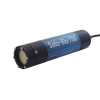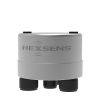Pro-Oceanus Mini TDGP Probe
Features
- Compact size with low power consumption
- Large selection of concentration ranges
- Internal data logger with 2GB flash memory
- Expedited repair and warranty service
- Lifetime technical support
- More
Overview
The Pro-Oceanus Mini TDGP measures the total dissolved gas pressure in liquids. It provides accurate TDGP data and is designed for use in aquaculture, dam spillways, groundwater monitoring and industrial applications.
Maintenance
Unlike other total gas pressure probes, the Mini TDGP is not affected by increasing hydrostatic pressure. The sensor’s semi-permeable membrane is also biofilm resistant. With periodic membrane cleaning and calibration checks, the Mini TDGP requires minimal maintenance.
Applications
The rugged Pro-Oceanus Mini TDGP sensor is designed for use in water, oil, and contaminated mixtures. The probe combines an oil-resistant membrane with a compact pressure sensor that provides quality TDGP data. The Mini TDGP sensor can be used for long-term deployments with simple, stable and accurate results.
| Sensor Performance | |
|---|---|
| TDGP Range | 0-2 bar Absolute 0-5 bar Absolute 0-14 bar Absolute *other ranges available |
| Resolution | 0.002% of Full Scale |
| Accuracy | ± 0.1% (Temperature compensated from -10 to 50º C) |
| Equilibration rate (t63) | Dependent on gas composition |
| Physical | |
|---|---|
| Length | 28 cm (11 in) |
| Diameter | 5.3 cm (2.1 in) |
| Weight | Air 0.53 kg (1.2 lbs) Water: -0.06 kg (-0.1 lbs) |
| Housing Material | Acetal Plastic |
| Depth Rating | 0 - 600 m |
| Water Temperature | -2º to 50º C |
| Electrical | |
|---|---|
| Input voltage |
7-24 VDC |
| Power consumption |
0.06 W (5 mA @ 12 VDC) |
|
Data output |
RS-232, ASCII format |
|
Sample Rate |
2 seconds |
All models include:
- Mini CO2 Instrument
- USB memory stick with Oceanus Software and User’s Manual
- QuickStart Guide
Power and communications deck box includes:
- Water-Resistant deck box with Underwater Cable and Connector Sleeve
- 2-meter RS-232 cable
- RS-232-to-USB Converter
- AC to DC 12 V Power Supply
Internal rechargeable battery models include the items above as well as a battery pack and charger.
In The News
Save our Bogs! Culture, Conservation and Climate Action in Ireland’s Peatlands
Characterized by long-term accumulation under waterlogged conditions, peatlands exist on every continent and account for 3-4% of the global land surface . Small but mighty, these often overlooked wetland environments are estimated to hold as much as one-third of the world's organic carbon in their soil—twice the amount found in the entirety of the Earth's forest biomass. While healthy peatlands can trap and store carbon, regulate water, and provide important habitats for rare species, human alteration has disturbed peatland carbon and nitrogen cycles on a global scale. Approximately 12% of the world’s peatlands have been drained and degraded through conversion for agriculture, forestry, infrastructure development, and other uses.
Read MoreSargassum Surge: How Seaweed is Transforming our Oceans and Coastal Ecosystems
Until recently, Sargassum –a free-floating seaweed–was distributed throughout the Sargasso Sea , the north Caribbean Sea, and the Gulf of Mexico. But in the space of a decade, this seaweed has, as one scientist remarks , “Gone from a nonfactor to the source of a terrible crisis.” Driven by climate change, anomalous North Atlantic Oscillation in 2009-2010 and a glut of anthropogenic pollutants, sargassum has proliferated. Seasonally recurrent mats as deep as 7m now bloom in the “Great Atlantic Sargassum Belt” (GASB), which covers areas of the Atlantic from West Africa to the Caribbean Sea and Gulf of Mexico. Every year, millions of tons wash up along the shores of more than 30 countries . Dr.
Read MoreGreat Lakes Research Center: Designing Targeted Monitoring Solutions
According to the National Oceanic and Atmospheric Administration ( NOAA ), the Great Lakes have more miles of coastline than the contiguous Atlantic and Pacific coasts combined and contain 20 percent of the world's freshwater, making it a critical region to protect and conserve. Continuous monitoring and data-informed resource management are key components of managing waters in the region. Hayden Henderson, a research engineer with the Great Lakes Research Center (GLRC), designs and deploys monitoring platforms throughout the Great Lakes. With a background in environmental engineering, Henderson enjoyed the challenge of creating systems and making them work to obtain difficult, remote measurements.
Read More





























